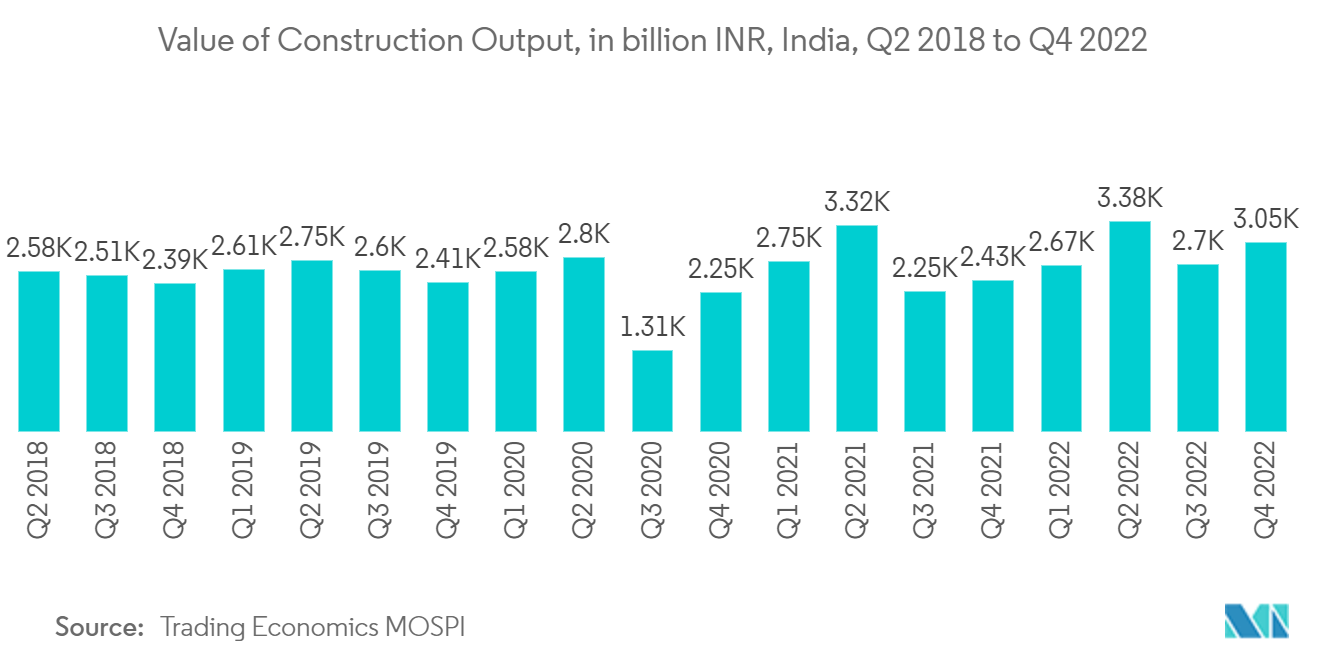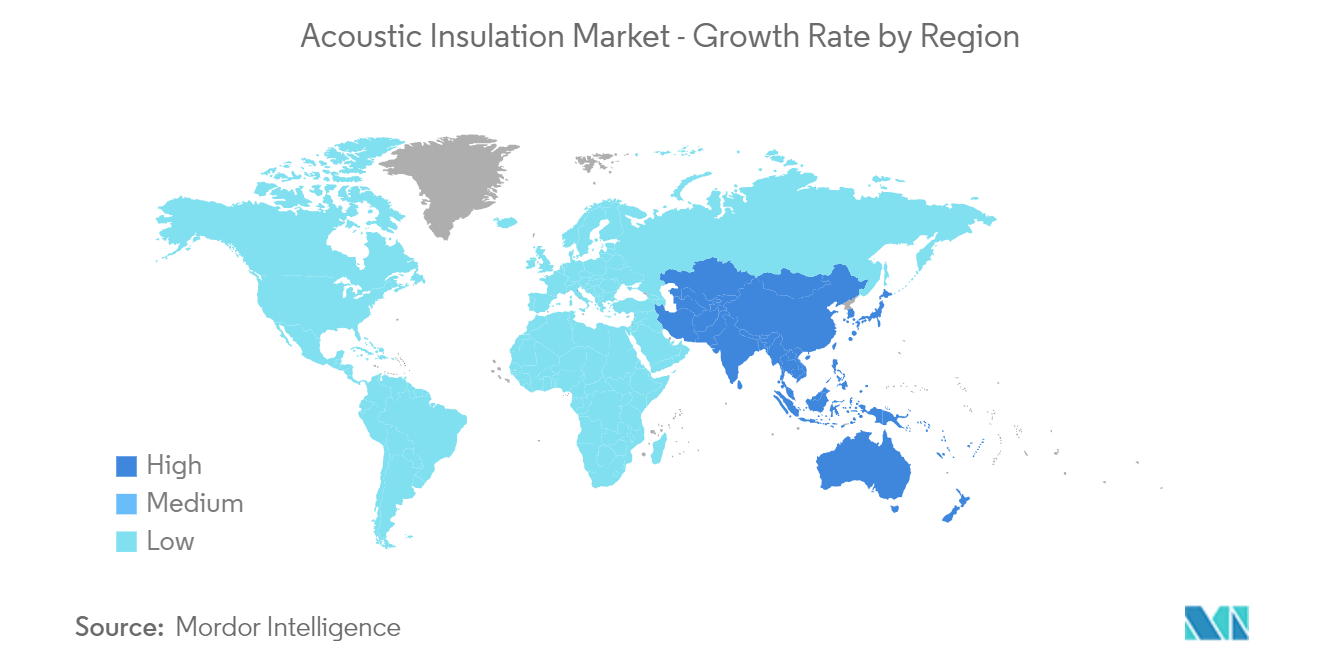Market Trends of Acoustic Insulation Industry
Rising Demand from the Commercial Construction
- The commercial buildings include offices, retail, cinema, and other leisure outlets used for conducting operations of the enterprises where acoustic insulation materials find extensive application in walls, floors, ceilings, waste-water pipes, plant rooms, etc.
- In commercial buildings, there are certain guidelines to avoid external noise intrusion, internal noise, and noise from building services. However, the type of insulation required in the building varies according to its structure and need. Commercial construction is growing noticeably in Asia-Pacific, the Middle East, and Africa.
- Asia-Pacific, Middle East, and African countries are experiencing huge domestic and foreign investments for setting up industrial units, hospitals, malls, theaters, the hospitality industry, and the IT sector. For instance, India's government approved a PLI scheme for 16 plants for key starting materials (KSMs)/drug intermediates and active pharmaceutical ingredients (APIs). Establishing these 16 plants would result in a total investment of INR 348.70 crore (USD 47.01 million). The commercial development of these plants is expected to begin by April 2023. Therefore, increasing investments from commercial and industrial units in India are expected to create significant demand for acoustic insulation materials.
- Asia-Pacific is an attractive market for foreign companies due to the healthy economic performance of the countries like India, China, Indonesia, etc., and efforts made by the Middle Eastern countries to develop tourism and other non-oil sectors. They are driving commercial construction activities in these regions. For instance, in Saudi Arabia, under Vision 2030, 80 new hotels with more than 11,000 luxurious rooms are expected to open across Saudi Arabia by 2030. Therefore, increasing investments in the construction of hotels is expected to create demand for the acoustic insulation market.
- India is anticipated to remain the fastest-growing G20 economy in the Asia-Pacific region. According to IBEF, it is estimated that India needs to invest USD 840 billion over the next 15 years into urban infrastructure to meet the needs of its fast-growing population. This investment will only be rational and sustainable if we additionally focus on the long-term maintenance and strength of our buildings, bridges, ports, and airports.
- Moreover, in India, the Minister of State, Civil Aviation, announced that under the regional connectivity scheme (RCS)-Ude Desh ka Aam Nagrik (UDAN) infrastructure scheme, the Indian government also planned to construct 100 airports by 2024, owing to increasing demand for air commute.
- Furthermore, Saudi Arabia is working on many commercial projects, likely leading to more commercial buildings. For instance, the kingdom announced the USD 500 billion futuristic mega-city "Neom" project, the Red Sea Project - Phase 1, which is expected to be completed by 2025. It includes 14 luxury and hyper-luxury hotels with 3,000 rooms spread across five islands and two inland resorts, Qiddiya Entertainment City, Amaala - the uber-luxury wellness tourism destination, and Jean Nouvel's Sharaan resort in Al-Ula.
- Hence, all such commercial construction investments and projects are driving construction activities in these countries, increasing the demand for acoustic insulation.

China to Dominate the Demand in the Asia-Pacific Region
- China holds the largest Asia-Pacific market share for acoustic insulation due to rising investments and construction activity. China is the biggest contributor, as it is one of the leading investors in infrastructure worldwide over the past few years. For instance, according to the National Bureau of Statistics (NBS) of China, in 2022, the output value of construction works in China amounted to CNY 27.63 trillion (USD 4108.58 billion), an increase of 6.6% compared with 2021.
- China is the largest economy in the Asia-Pacific region in terms of GDP. The growth in the country remains high. However, it is gradually diminishing as the population ages, and the economy is rebalancing from investment to consumption, manufacturing to services, and external to internal demand.
- Automotive acoustic insulation is a vital part of the vehicle. It reduces the noise produced by various moving parts in the vehicle. The excess noise reduces the comfort level of both drivers and passengers, resulting in increased fatigue and stress. Automotive remains the largest sector in the country and reflects positive signs for the near future. For instance, according to Organisation Internationale des Constructeurs d'Automobiles (OICA), in 2022, automobile production in the country amounted to 2,70,20,615 units, which shows an increase of 3% compared with 2021. Therefore, such a positive scenario in the production of automobiles in the country is expected to create an upside demand for acoustic insulation materials.
- Furthermore, China will overtake the United States as the world's biggest air travel market within the next three years. Still, the country's appetite for aviation continues to grow exponentially. For instance, during a French state visit to China, Airbus signed new cooperation agreements with China's Aviation industry partners. According to Airbus, over the next 20 years, China's air traffic is forecast to grow at 5.3% annually, significantly faster than the world average of 3.6%. It will lead to a demand for 8,420 passenger and freighter aircraft between 2023 and 2041, representing more than 20% of the world's total demand for around 39,500 new aircraft in the next 20 years. It is due to the rising aircraft fleet throughput further augmenting the development and growth of the acoustic insulation market.
- Furthermore, countries such as India and Japan contribute to the studied market growth. It is expected to further drive the demand for acoustic insulation over the forecast period.


